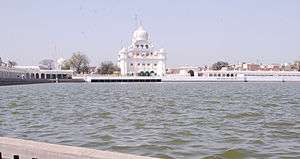Maghi
Maghi is the annual festival and one of the seasonal gathering of the Sikhs.[1] It is celebrated at Muktsar in the memory of forty Sikh martyrs (Chalis Mukte), who once had deserted the tenth and last human Guru of Sikhism, Guru Gobind Singh at Anandpur Sahib, but later rejoined the Guru and died while fighting the Mughal Empire army led by Wazir Khan in 1705.[1] Sikhs make a pilgrimage to the site of this Sikh-Mughal war, and take a dip in the sacred water tanks of Muktsar.[2][3]
| Maghi | |
|---|---|
 | |
| Observed by | Sikhs |
| Type | religious and cultural |
| Significance | Midwinter festival, celebration of Winter Solstice |
| Celebrations | Ritual bathing, eat traditional food |
| Begins | 1st Magh Sangrand Punjabi calendar |
| 2019 date | Monday, 14 January |
| Frequency | annual |
| Related to | Makar Sankranti |
A fair (mela) is held at Muktsar Sahib every year and called the Mela Maghi is held in memory of the forty Sikh martyrs.[4] Before this tradition started to commemorate the Sikh martyrs who gave their lives to protect the tenth Guru, the festival was observed and mentioned by Guru Amar Das, the third Guru of Sikhism.[5]
Makar Sankranti (or Pongal) is celebrated in other parts of Indian subcontinent by Hindus, [6] and is always on the first day of the month of Magha in Bikrami calendar. On Maghi, when the sun takes its northern journey on entering the sign of Makara or Capricorn, the Hindus take bath in the Ganges or if that is not possible, in some other river, rivulet, canal or pond.[6] It follows the festival of Lohri in north India, particularly popular in the Punjab region.[7]
Maghi is celebrated by people eating kheer such as Rauh di kheer which is an old dish where rice is cooked in sugarcane juice. The dish is prepared in the evening before Maghi and is kept to cool. It is served cold next morning on Maghi with red-chili mixed curd.[8] In some parts of Punjab, India, it is also traditional to eat kichdi mixed with lentils, consume raw sugarcane and jaggery,[9] Fairs are held at many places on Maghi.[10]
See also
- Makar Sankranti
- Sankranti
- Thai Pongal
- Winter Solstice
- Lohri
- Maghe Sankranti
References
| Wikimedia Commons has media related to Festivals of Punjab. |
- J. Gordon Melton; Martin Baumann (2010). Religions of the World: A Comprehensive Encyclopedia of Beliefs and Practices, 2nd Edition. ABC-CLIO. p. 1769. ISBN 978-1-59884-204-3.
- Business Standard 14 January 2015
- Tony Jaques (2007) Dictionary of Battles and Sieges: F-O. Greenwood Publishing Co.
- Fenech, E. Louis; Mcleod, H. W. Historical Dictionary of Sikhism. Rowman & Littlefield. p. 65. ISBN 978-1-4422-3601-1.
- Jawandha, Major Nahar Singh (1 January 2010). "Glimpses of Sikhism". Sanbun Publishers. Retrieved 14 September 2016 – via Google Books.
- Census of India, 1961: Punjab. Managher of Publications
- Dr. H.S. Singha (2005). Sikh Studies. Hemkunt Press. pp. 101–102. ISBN 978-81-7010-245-8.
- 'Rauh di kheer’ is the people’s favourite. The Tribune. (14.01.2017 )accessed 15.01.2017
- Sundar mundarye ho by Assa Singh Ghuman Waris Shah Foundation ISBN B1-7856-043-7
- Sekhon, Iqbal S. The Punjabis. 2. Religion, society and culture of the Punjabis. Cosmos (2000)
